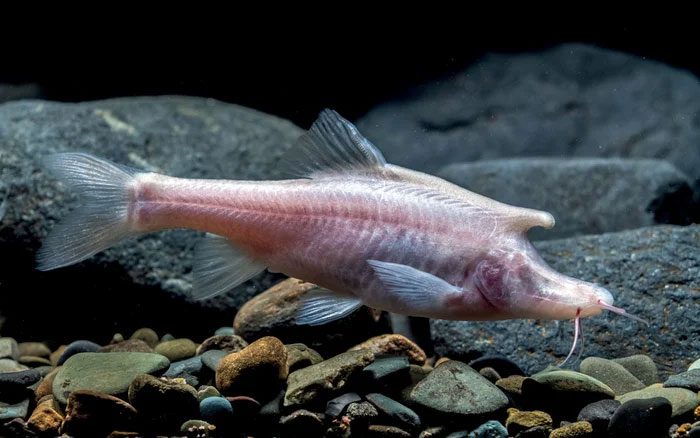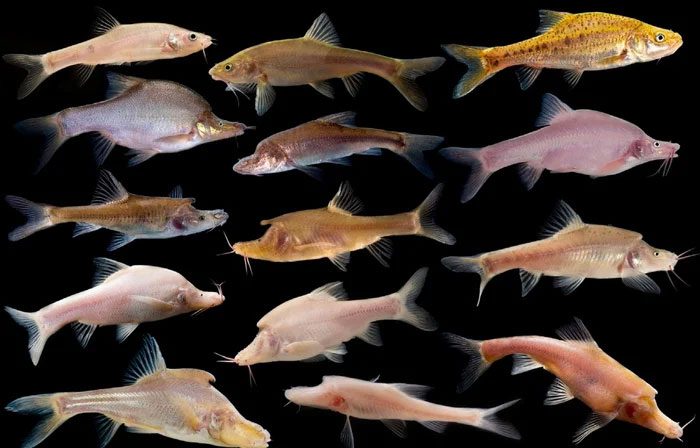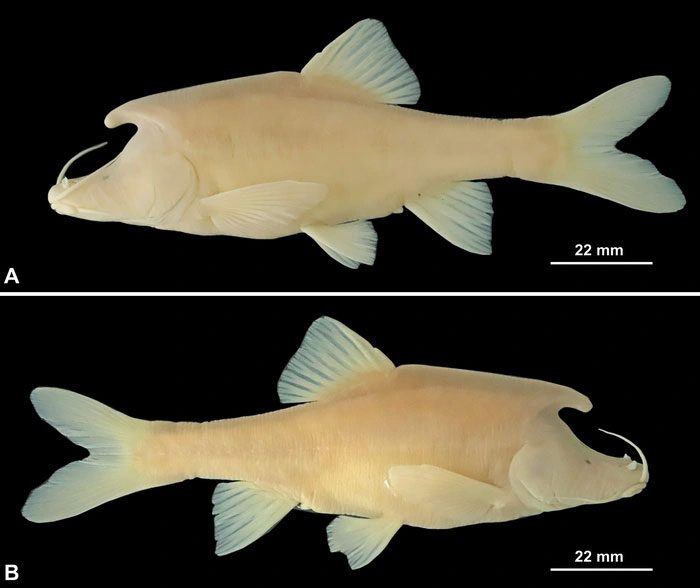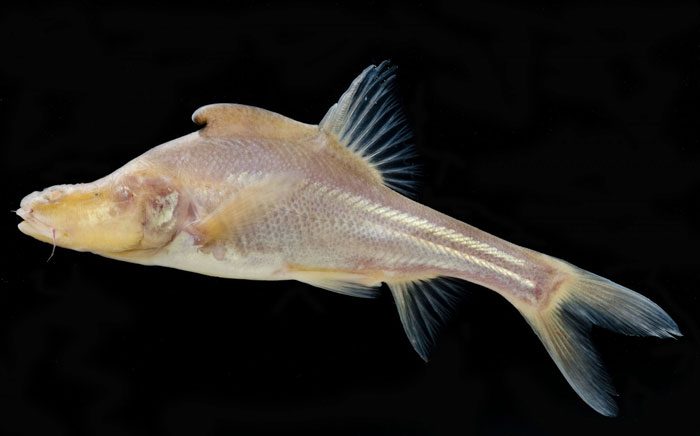Sinocyclocheilus longicornus is a newly discovered fish species found living in a cave in the southwestern province of Guizhou, China.
Sinocyclocheilus is a genus of freshwater fish in the family Cyprinidae, endemic to China. First described in 1936, it comprises 76 valid species, of which 71 species are grouped into five species groups.

Sinocyclocheilus is a genus of freshwater fish in the family Cyprinidae, endemic to China.
Most members of this fish genus live in or around caves, and they typically exhibit characteristics typical of cave-dwelling fish, such as the absence of scales, lack of pigmentation, and reduced eyesight. Some species may have “horns” at the back of their heads, but the exact function of these horns remains unclear.
In contrast, surface-dwelling species and a few found underground do not show distinct adaptations typical of cave fish.

There are many theories suggesting that Sinocyclocheilus has adapted to cave habitats to cope with the aridity of China during the late Miocene and Pliocene periods.
Dr. Jiang Zhou from Guizhou Normal University and colleagues state: “The Sinocyclocheilus genus is endemic to China and primarily distributed in limestone mountainous areas in Southwest China, including the provinces of Guangxi, Guizhou, Yunnan, and Hubei.“
“The narrow distribution, morphological similarities, and adaptations to cave environments, such as the degeneration or loss of eyes and body scales, have made the classification of the genus challenging and often controversial.”
Scientists noted: “Sinocyclocheilus species generally exhibit varying degrees of eye development and horn-like structures at the back of their heads.”
“Eye morphology includes normal eyes, small eyes, and anophthalmia.”
“Species with normal and small eyes are distributed from eastern Guangxi through southern Guizhou to eastern Yunnan, while eyeless species are primarily found in the Hongshui River basin in northern Guangxi and the Nanpan River basin in eastern Yunnan.”
“Horn-like structures are mainly present in species within the Sinocyclocheilus angleis and Sinocyclocheilus microphthalmus groups.”
“These horned species are distributed in the basins of the Nanpan River, Beipan River, and Hongshui River in the upper reaches of the Zhujiang River.”

Adaptive features such as eye degeneration and horn evolution are found in branches related to cave systems in Guangxi and Guizhou provinces. Studies combining various methods, such as morphology, phylogeny, ratio analysis, molecular dating, and distribution analysis, have revealed both distinct patterns and exceptions in the evolutionary process of Sinocyclocheilus, making it a valuable model for exploring evolutionary novelty.
The newly described species Sinocyclocheilus longicornus was found in a single location, a vertical cave approximately 2,276 meters above sea level near Hongguo town in Guizhou province, China.
Researchers stated: “There is no light inside the cave. Individuals of the Sinocyclocheilus longicornus species are located in a small pool about 25 meters from the cave entrance.”
“This pool is approximately 1.8 meters wide and 80 centimeters deep, with a water temperature of 16 degrees Celsius and a pH of 7.4 at the time of sampling.”
Sinocyclocheilus longicornus has a body resembling that of albino fish, lacking scales, without pigmentation, and has small, degenerated eyes. It also features a single, relatively long horn-like structure without branches at the back of its head.
Scientists further stated: “Sinocyclocheilus longicornus clusters with eight species from the Sinocyclocheilus angularis group on the phylogenetic tree and can be divided into Clade I and Clade II. The horn-like structures vary in length and appear in both Clade I and Clade II.”
“Based on current research and previous phylogenetic trees, we hypothesize that the evolution of this horn may have occurred in at least two independent forms from a weakening event and a loss event.”
“Regarding the eyes, this may relate to the reduction in eye size during evolution or the abundance and scarcity of food resources during growth and development, as well as related gene mutations.”
The discovery of the new fish species – Sinocyclocheilus longicornus is reported in a paper published in the journal ZooKeys.

Through morphological analysis and comparison using DNA barcoding technology, scientists have identified this as a new species and named it “golden horn catfish” due to its long, developed horn-like structure protruding from the back of its head.
|
Cyprinidae is the family of carps, which includes carps and several closely related species such as barbs, loaches, and more. Fish in this family likely originated from North America, Africa, and the Eurasian continent. The largest known species in this family is the giant barb (Catlocarpio siamensis), which can grow up to 3 meters in length. The largest species in North America is Ptychocheilus lucius, which can reach lengths of up to 1.83 meters. Conversely, this family also includes many species smaller than 5 cm; the smallest freshwater fish is Danionella translucida found in Myanmar, measuring only up to 12 mm. All species in this family are egg-layers, and the reproductive behavior of most species is non-guarding of eggs; however, a few species do build nests or guard their eggs. |


















































